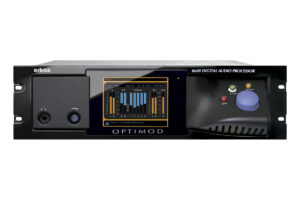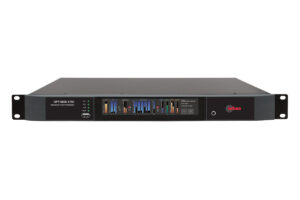Orban OPTIMOD 8600
Featuring versatile five-band and two-band processing for both analog FM transmission and digital media, the 8600 provides the industry’s most consistent sound, track-to-track and source-to-source. This consistency allows you to create a sonic signature for your station with the assurance that your signature will stay locked in, uniquely branding your sound.
The 8600 provides stereo enhancement, equalization, AGC, multiband compression, low-IM peak limiting, stereo encoding, and composite limiting — everything that even the most competitive major market station needs to stand out on the dial. More than 20 excellent sounding, format specific factory presets get you started. You’ll find all of your favorite 8500 presets, plus “MX” presets designed by Bob Orban and Greg Ogonowski to exploit the exciting possibilities inherent in the 8600’s new peak limiter technology. Although the factory presets are fully competent “out of the box, you can customize them with easy one-knob LESS-MORE control in Basic Control, with 50 parameters Intermediate control or with more than 120 in the Advanced controls, whose versatility will satisfy even the most finicky on-air sound designer. The new added phase skew corrector maximizes the quality of a mono mixdown or blend that might occur in a receiver.
Featuring versatile five-band and two-band processing for both analog FM transmission and digital media, the 8600 provides the industry’s most consistent sound, track-to-track and source-to-source. This consistency allows you to create a sonic signature for your station with the assurance that your signature will stay locked in, uniquely branding your sound.
The 8600 provides stereo enhancement, equalization, AGC, multiband compression, low-IM peak limiting, stereo encoding, and composite limiting — everything that even the most competitive major market station needs to stand out on the dial. More than 20 excellent sounding, format specific factory presets get you started. You’ll find all of your favorite 8500 presets, plus “MX” presets designed by Bob Orban and Greg Ogonowski to exploit the exciting possibilities inherent in the 8600’s new peak limiter technology. Although the factory presets are fully competent “out of the box, you can customize them with easy one-knob LESS-MORE control in Basic Control, with 50 parameters Intermediate control or with more than 120 in the Advanced controls, whose versatility will satisfy even the most finicky on-air sound designer. The new added phase skew corrector maximizes the quality of a mono mixdown or blend that might occur in a receiver.
Improved Peak Limiter Technology
Dramatically improved peak limiter technology decreases distortion while increasing transient punch and high frequency power handling capacity. Compared to the FM-channel peak limiter in OPTIMOD-FM/HD 8500, the new peak limiter typically provides 2.5 to 3 dB more power at high frequencies, which minimizes audible HF loss caused by pre-emphasis limiting. Drums and percussion cut through the mix. Highs are airy. “Problem material” that used to cause audible distortion is handled cleanly.
While this design offers about the same loudness as 8500 processing, its main goal is to make FM analog broadcasts more competitive with the cleanliness, punch, and open high frequencies of the digital media against which FM analog transmissions now battle. The FM loudness wars represent 20th-century thinking; in the 21st century, the new competition is digital media. Thanks to its fresh, crisp sound, the 8600 helps level the playing field between analog FM and its ever more aggressive digital-only competitors.
Diversity Delay
For Digital Radio broadcasters who prefer using a separate processor for the digital channel, the 8600’s built-in delay (up to 16 seconds) in the analog processing path vastly improves installation versatility in HD Radio facilities, freeing you from the need to use the delay line built into the Digital Radio exciter. This allows you to use the 8600FM’s built-in stereo encoder and composite limiter to drive the analog FM transmitter, ensuring no-compromise analog-channel loudness.
Independent Processing
The 8600’s x HD (“Digital Radio”) output is designed to feed streaming, netcasting, and digital satellite or cable radio channels, which can be Eureka 147, DRM, DAB + or the iBiquity® HD Radio system (formerly known as “IBOC” – “In-Band On-Channel”). The equalizer and five-band compressor/limiter in the HD processing chain have their own sets of user-adjustable audio controls that are independent of the controls in the FM analog transmission chain’s equalizer and five-band compressor/limiter. The bottom line? Processing that optimizes the sound of your FM channel while punching remarkably crisp, clean, CD-like audio through to your digital channel audience.
Loudness and True Peak control
The Digital Radio and analog radio processing chains offer ITU-R BS.1770-3 + Loudness Meters and Safety Limiters for use in countries that enforce a BS.1770 loudness limit on digital and/or analog radio broadcasts.
The 8600 implements “true peak” control in the HD processing kHz. This allows the 8600 to prevent clipping in a playback device’s analog signal path by predicting and controlling the analog peak level follow the playback device’s reconstruction filter to an accuracy of better than 0.5 dB. For typical program material, accuracy is 0.2 dB. Without true peak control, analog clipping can occur even if all peak values of the digital samples are below 0 dBFS. This phenomenon has also been termed “0 dBFS+.”
Thanks to true peak control, sample rate conversion, unless it removes high frequency program energy or introduces group delay distortion, cannot cause sample peaks to increase more than 0.5 dB.
Versatility doesn’t stop with sound.
The 8600 has an internal, DSP-based stereo encoder (with a patented “half-cosine interpolation” composite limiter operating at 512 kHz sample rate) to generate the pilot tone stereo baseband signal and control its peak level. The composite limiter is a unique, “you can only do this in DSP” process that beats composite clippers by preserving stereo imaging while fully protecting the stereo pilot tone, RDS/RBDS, and subcarriers.
The stereo encoder’s stereo subchannel modulator can operate in normal double sideband mode and in an experimental compatible single sideband mode that is offered to enable users to compare and assess the two modes.
For our European customers, a second generation ITU BS 412 multiplex power controller yields the best possible coverage while flawlessly complying with the standard. You can adjust it to maximize loudness within the constraints of the BS 412 standard or to produce less gain change at the expense of slightly lower loudness. New for the 8600 is the ability to apply MPX power gain reduction after the clippers so that the texture of the processing can include more “clipper sound” when desired. Regardless of how you adjust the multiplex power controller, you can be sure that you will always meet the BS 412 requirements flawlessly.
A loop-through connection is provided to enable a ratings encoder (such as Arbitron®) to be inserted between the output of the AGC before the analog-FM and HD processing paths split, allowing a single ratings encoder to be used for both the analog FM and HD channels or between your Optimod’s left/right audio processing and stereo encoder, maintaining consistently high audio drive levels into the ratings encoder while allowing your Optimod’s composite limiter to be used. Analog Fallback to Digital control that allows Silence Sense to switch the active input from Analog to Digital if silence is detected in the analog input signal but not on the digital input signal. This function works vice versa as well on both analog and digital AES input. The silence sense parameters apply to both simultaneously and both detectors are available to drive the 8600’s tally outputs and sending SNMP Traps/Alerts.
RDS
The 8600 includes a full-featured RBS/RBDS generator at no additional charge. The generator supports dynamic PS. It can be controlled via 8600 presets and an ASCII terminal server that can be connected to automation to support displaying title and artist.
Controllable
User interface improvements round out the package. The easy-to-use joystick, knob and button navigation system and a bright, active-matrix color LCD that makes it easier to program the 8600 from its front panel. Ethernet connectivity is standard, as is an easy to use PC remote control application that runs on Windows 2000, XP, Vista, 7, 8, 8.1 and 10 that can control many 8600s on a TCP/IP network. In addition, programmable contact-closure (GPI) control plus ACSII terminal control via the 8600’s RS232 serial and Ethernet ports and give you total freedom to interface the 8600 with your facility’s remote control infrastructure, whatever it might be.
Administrating and Monitoring
The SNMP (Simple Network Management Protocol) features allow you to monitor your Optimod’s status and to send Alarm notifications via your Optimod’s Ethernet connection to your network. API: This interface can be used to allow custom third-party applications (including auto-mation systems) to recall presets, view status and set the controls.
Only logged in customers who have purchased this product may leave a review.
Related products
Broadcast processor
Broadcast processor
Broadcast processor
Broadcast processor
Broadcast processor
Broadcast processor
Broadcast processor
Broadcast processor






















Reviews
There are no reviews yet.